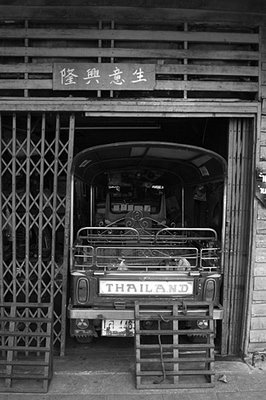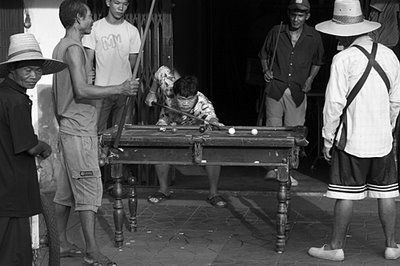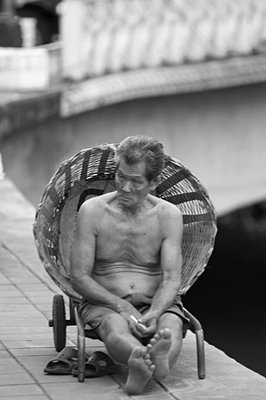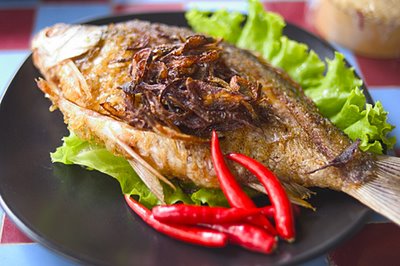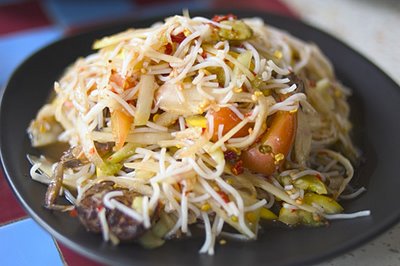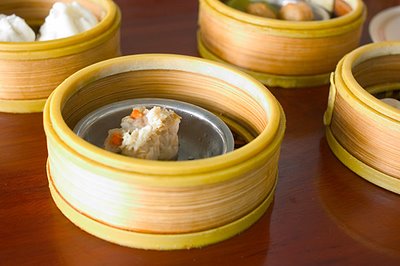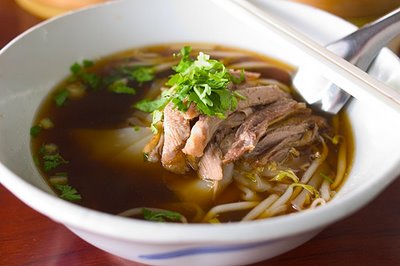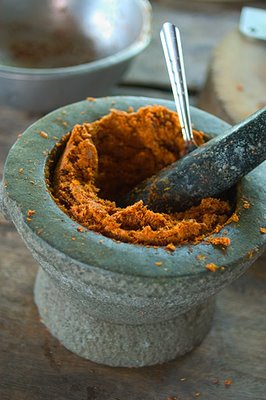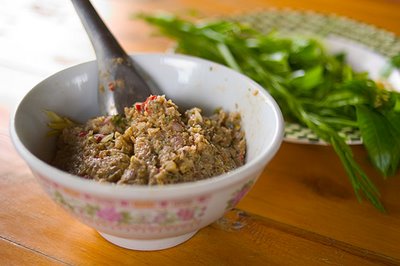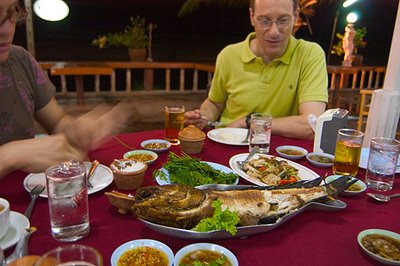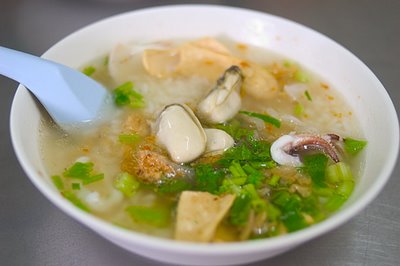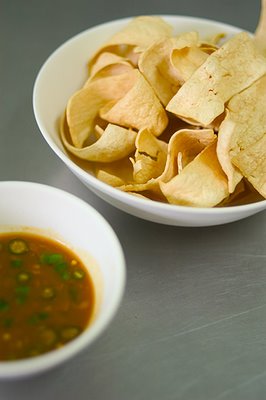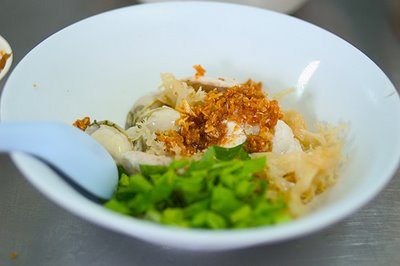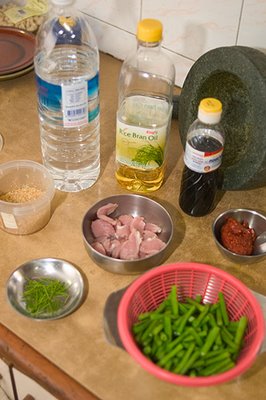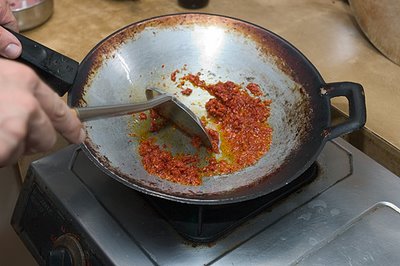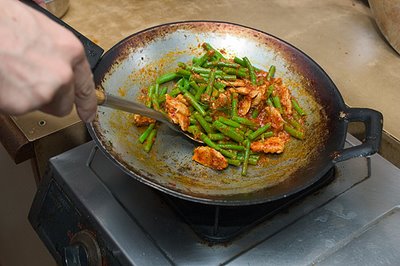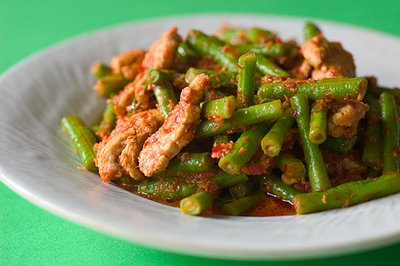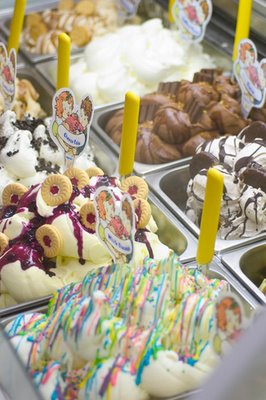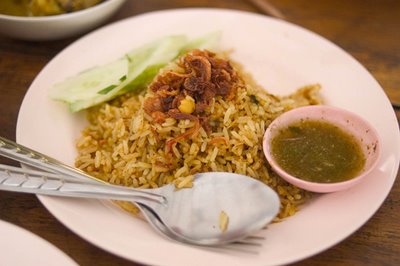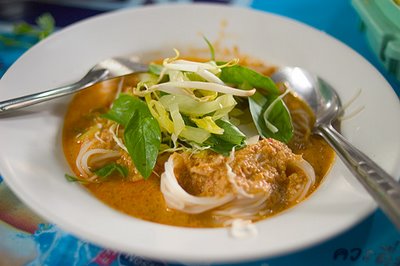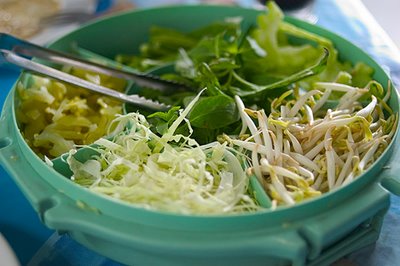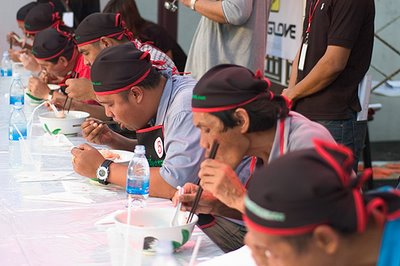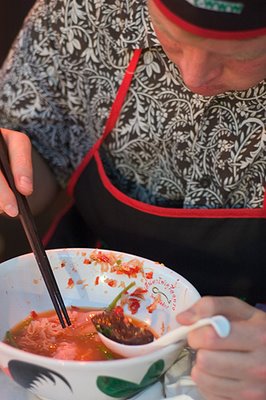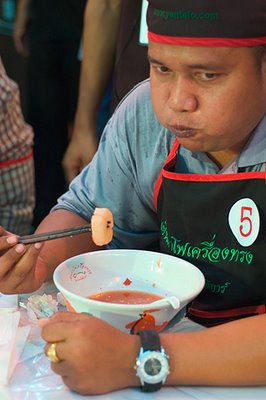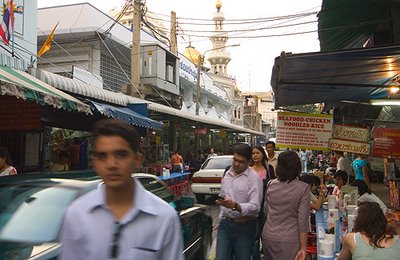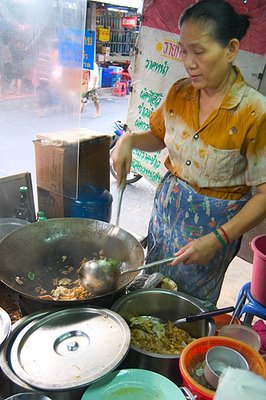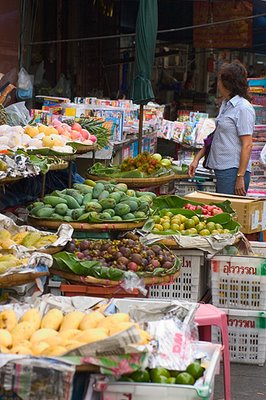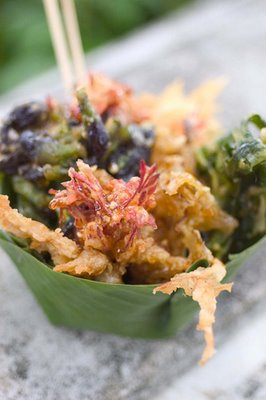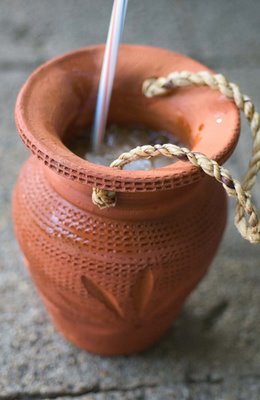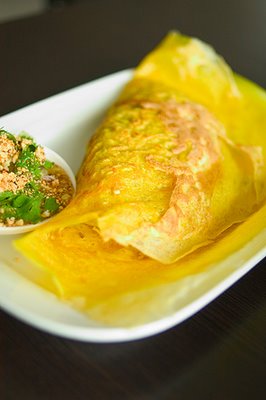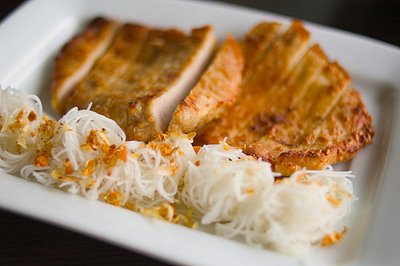The following is a piece that I wrote several months ago about the food of Luang Prabang, Laos. Unfortunately the article was never printed, but to put it to some use I've decided to post it here. Incidentally, I do have photos to accompany the text, but they will be used to illustrate a similar piece currently being written by Bangkok-based writer which will run in an undisclosed magazine. So it's probably best not to post them here just yet. Enjoy!
I first visited Luang Prabang in 1998, when the most common way to visit the former royal capital was an arduous two-day boat trip from Chiang Khong, Thailand. Grimy backpackers mingled with homebound locals on the noisy ferry, and through the windows, Laos seemed very much like unexplored territory. Arriving in Luang Prabang, I was amazed to have found such a delightful place that had seemingly not yet been exploited by modern tourism. Accommodation was abundant and more than adequate, but the town’s food, typically quasi-Thai cuisine in overpriced restaurants, or the ubiquitous Vietnamese noodle soup, pho, left a great deal to be desired. The local cuisine was said to be interesting, but was really only available in take-home form from the evening market.
Fast forward nearly eight years and Luang Prabang is clearly on the beaten track. Tourists can now fly directly from Bangkok, and spas, boutique hotels, and high-end shopping are all firmly established. And as a result of all this activity, food, the one area that traditionally lagged behind for so long, is finally starting to catch up. The cuisine of Luang Prabang, for years a concept virtually unknown to the outside world, is by no means generating a buzz, but is grabbing attention, and is finally there for those who are willing to try it.
What have we been missing out on then? To get an idea of the food of Luang Prabang, the best place to go is the town’s daily evening market. It is here where vendors line the streets peddling the flavours of Luang Prabang: bright-red pork curries, grilled Mekong River fish, “salads” of local vegetables, homemade pork and herb sausages, and steaming baskets of sticky rice. The food of Luang Prabang is simple, honest and earthy, relying much on the use of vegetables, herbs, often those having a bitter-spicy flavour, ahaan paa, game from the jungle, and fish from the Mekong River. Unfortunately, the food at the evening market is sold to be eaten at home, and there are no tables or chairs.
However, if you like what you have seen, and you’re ready to taste Luang Prabang, a good starting point is the delightfully unpretentious, third-generation restaurant, Maly Lao Food. “We’re the only restaurant in Luang Prabang that serves authentic local food,” explains Yinthorn Dalachit, son of the restaurant’s namesake. He describes how his mother, Thai by birth, married a high-ranking resident of Luang Prabang and learned the local recipes well enough to become a chef in the former royal palace. The monarchy was abolished along with the advent of communism in 1975, but many of the recipes still survive and are now served in the restaurant.
The restaurant’s optimistic but barely-legible English-language menu doesn’t help much, but simply opening the first page (“Luang Prabang Specialties”) and pointing to a dish at random will virtually guarantee a good choice. With the benefit of experience, I order yam salat, a salad made from a variety of local watercress known as phak naam. The dish resembles a western salad, but the dressing, a tart mixture of lime juice, egg and ground peanuts, is unmistakably Asian. “This dish is very local,” explains Dalachit. “It is always served at any sort of festival or celebration in Luang Prabang.” Other specialties of the restaurant include or laam phak, a thick, savory stew of vegetables and local herbs, and laab paa, a “salad” of minced Mekong River fish with a spicy-tart dressing.
For a more upmarket take on the local cuisine, the Restaurant Les 3 Nagas is easily Luang Prabang’s most ambitious restaurant. An anomaly of sorts, Les 3 Nagas is a fine dining restaurant serving humble Luang Prabang dishes to a mostly foreign clientele. The owner, Yannick Upravan, describes the menu as “real Lao”, but admits that to suit foreign palates, he has compromised on the level of spiciness. “In the beginning I invited my family [to eat at the restaurant], and they said the food was good, but not spicy enough,” he relates, laughing. Ranging from local takes on well-known Lao dishes such as laab, to obscure specialties such as khai phaen, crispy sheets of Mekong river weed, the restaurant’s menu is a virtual encyclopedia of traditional Luang Prabang cuisine.
Ironically, Upravan’s first contact with the food of Luang Prabang came while he was living with relatives as a cooking school student in France. “My aunt’s husband was from Luang Prabang, and in France I ate Luang Prabang food every day,” he recounts. “When I came Luang Prabang I knew the flavours and tastes of the foods, but didn’t know the names. Everybody asked me, ‘How did you learn these recipes living in France?’”
In 2000 Upravan noticed the lack of fine dining in Luang Prabang, and he and a partner opened L’Elephant, a French bistro-style restaurant. An interest in the local cuisine of Luang Prabang’s continued to haunt him though. “Next door to L’Elephant was an aunt of mine,” explains Upravan. “She spent all day in the kitchen making Luang Prabang food, and I could smell this from L’Elephant. We began to exchange food, croissants for Luang Prabang dishes, and when she cooked something I asked her for the recipes.” This growing interest in the local food inspired Yannick to open a restaurant wholly dedicated to the food of Luang Prabang.
I ask Yannick to describe the flavours of Luang Prabang cuisine, and he replies “rustique”. “For instance, or laam,” explains Upravan, describing the thick herb-laden stew—a staple of Luang Prabang cuisine, “has meat, vegetables and paa daek [Lao-style fish sauce]. In the beginning you smell the paa daek, then you taste the flavour of the meat, and then finally the spiciness of the herbs. In this dish there are many tastes,” he explains.
And this complexity is certainly the case with the food at Les 3 Nagas. The food of Luang Prabang is subtle and earthy, slowly approaching you rather than hitting you in the face like Thai food often does. I order jaew bong, a paste of crushed dried chilies, garlic, shallots and buffalo skin that is probably Luang Prabang’s most famous dish. Eaten with sticky rice, the jaew bong is savory and heady—not as spicy as the amount of chilies would suggest, and it takes a few bites before I can really get a grasp on the wide variety of flavours at work.
Another highlight in Luang Prabang’s emerging culinary scene is the Maison Souvannaphoum’s restaurant, L’Elephant Blanc. The hotel and restaurant are located in the home of a former member of Luang Prabang’s royal family, Souvanna Phouma, and L’Elephant Blanc’s executive chef, Vanhsay Picknock, has created a menu that includes Lao and French cuisine, as well as dishes that were once favored by the prince, such as kaeng som kalampi, a sour soup of pork, white cabbage, and herbs such as lemongrass.
The restaurant’s menu also includes a few Luang Prabang specialties. “We have three old local ladies working in the kitchen,” explains Picknock. “We keep them around because they know the local recipes,” laughs the Vientiane-born chef. Local dishes at L’Elephant Blanc include sai ua, a sausage of pork and fresh herbs, and ua nor mai, a tender bamboo shoot stuffed with savory pork and deep-fried. “I was surprised,” replies Chef Vanhsay, when asked how foreign diners respond to local cuisine. “Foreigners who come here can eat Lao food, but if Lao people go to Europe, they probably won’t be able to eat the food,” explains the chef.
Luang Prabang, as well as the rest of Laos, was a French colony for more than 50 years, and the French left a significant culinary legacy, including baguettes, called khao jii by the Lao, and the ubiquitous coffee. This legacy is also evident in Luang Prabang’s numerous French restaurants. The best of these is L’Elephant, also co-owned by Yannick Upravan and his business partner, Gilles Vautrin. The restaurant, opened in 2000, serves, in the words of Mr. Vautrin, “simple, honest French bistro-style food”.
The menu at L’Elephant ranges from French staples using imported ingredients, such as escargots de Bourgogne, to more innovative dishes combining ingredients unique to Luang Prabang with French cooking styles, such as Bouquet de Cresson a la Vinaigrette, a salad using the local watercress. A particular highlight is the use of wild game such as boar and venison, manifest in the restaurant’s Terrine de Sanglier au Poivre Vert et au Cognac, Wildboar Terrine with Green Pepper and Cognac. L’Elephant also has its own organic farm with herbs such as basil and parsley, and salad vegetables such as rocket and frisee. “Sometimes during the high season we couldn’t get all the produce we needed, so we started up our own garden,” explains Gilles. “The produce is better quality and cleaner, and we even sell produce to other restaurants in Vientiane.”
Upscale local cuisine. Imported snails from France. Frisee in Laos. As I exit L’Elephant on my last night in Luang Prabang, reflecting on these culinary anomalies, my eye catches a snapshot of one of L’Elephant’s former customers: Mick Jagger. In this instant I’m convinced that yes, the food in Luang Prabang finally has caught up.












